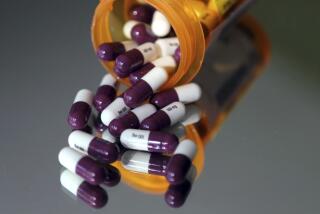A Former Disappointment Now Offers Hope
- Share via
Two years after the supplement SAMe was introduced in the United States as a potential, but never proved, remedy for depression and arthritis, researchers may have found a condition it actually helps--chronic liver disease.
Such disease, especially liver disease caused by alcoholism, currently has few effective treatments, so the possibility is generating enthusiasm among researchers and physicians alike. USC has launched a study to see how the supplement works among alcoholics, and the National Institutes of Health is holding a conference on the supplement later this week.
“We are still in the early stages of research,” said Dr. Charles Lieber, director of the alcohol research center at the Bronx VA Medical Center in New York. “But we have already established compelling evidence that SAMe has a striking effect.”
A 1999 study published in the Journal of Hepatology showed that a group of alcoholics who received SAMe had a 30% reduction in deaths and liver transplants, compared with a group of patients who did not receive the supplement.
SAMe, which stands for S-adenosylmethionine, is a compound made primarily in the liver as a byproduct of the metabolism of the amino acid methionine. It was first marketed in the United States in 1999 as a natural remedy for depression, arthritis, liver and heart disease. There are preliminary, or small, studies showing that it may be helpful for all of those conditions, but nothing conclusive, experts say.
Moreover, the over-the-counter preparations of SAMe are not regulated by the federal government for safety or effectiveness.
“Compared to some alternative medicine treatments, this one has a peppering of scientific interest. It’s definitely worth looking at,” said Dr. Caroline Reilly, assistant medical director of the American Liver Foundation. “But it’s hard to think that something will be so promising when you encounter it at the checkout counter at Walgreens.”
SAMe products sold in stores, which typically come in 200 milligram tablets, may not even work, said Dr. Shelly C. Lu, a professor of medicine at USC who has studied SAMe. Consumers shouldn’t try to self-treat a serious liver disease with SAMe.
“I doubt that the nutritional supplement dose in this country will be therapeutic,” she said. “The therapeutic doses appear to be much higher.”
Nevertheless, the preliminary evidence on SAMe’s effect on the liver is good enough--and the other options for treating liver disease are poor enough--that it’s important for more doctors to know about SAMe, Lieber said.
“Liver disease is a serious condition. It requires management that should be handled by a physician,” he said. “What is needed is an educational campaign so that physicians know about this potential therapeutic agent.”
Though SAMe is expensive, costing about $1 per 200-milligram pill, it doesn’t appear to cause side effects or be toxic at high doses. “SAMe is fairly benign,” Lu said. “It’s something we make in every cell. SAMe is involved in so many different processes in the cell, so its role is phenomenal.”
Research has shown that patients with alcoholic liver disease and other liver disorders have abnormal methionine metabolism, which depletes SAMe and contributes to the deterioration of the organ. Giving liver patients methionine doesn’t work, Lu said. However, supplementation with SAMe does show promise.
“We have accumulated evidence that clearly demonstrates if the liver SAMe is low, it will set up a vicious cycle that will predispose the liver to injury,” she said. “Essentially, SAMe corrects a basic defect.”
“I’m not saying SAMe is going to have an effect on acute liver disorders,” she said, adding that it may be most beneficial in early-stage liver disease.
SAMe treatment for liver disease is not a new concept. The supplement is sold as a prescription drug for liver disease in most of Europe. But the lack of SAMe studies that meet rigorous U.S. research standards have thwarted its acceptance in this country.
The current research on SAMe and a variety of liver disorders is mostly taking place outside the United States, said Dr. Mary Hardy, director of Integrative Medicine at Cedars-Sinai Medical Center in Los Angeles. Hardy helped direct a federally funded report, due out later this year, that will summarize the evidence for SAMe’s value in treating depression, arthritis and liver disease.
“There is a rationale for how SAMe might be helpful in the liver,” said Hardy, who also plans to launch a small study on SAMe’s benefits in people with hepatitis C. “I think there will be some larger and better studies still to be done that will be very useful.”
U.S. research has also been hampered by SAMe’s nonprescription status. Without patent potential, drug companies are not interested in exploring SAMe, Lu said. “It’s also unfortunate that it’s a supplement because that means insurance companies won’t pay for it,” she said.
Basic research by Lu, Lieber and others, however, has prompted federal health authorities to sponsor additional research on SAMe and liver disease. Chronic liver disease, which can be caused by drugs, alcohol or viruses, is the 10th-leading cause of death in the United States. About 2 million Americans have alcoholic liver disease. Los Angeles County has an excessively high rate of alcoholic liver disease, according to patient discharge data from the California Office of Statewide Health Planning and Development.
“For most of the chronic liver diseases, the treatment efficacy is lousy,” Lu said. “Here we have something that is completely benign.”
Though alcoholic liver disease is the subject of many of the recent SAMe research, interest in looking at the supplement in people with hepatitis is growing, Lieber said.
“Alcoholic liver disease is a very promising area,” he said, “but potentially it can benefit in other diseases.”





